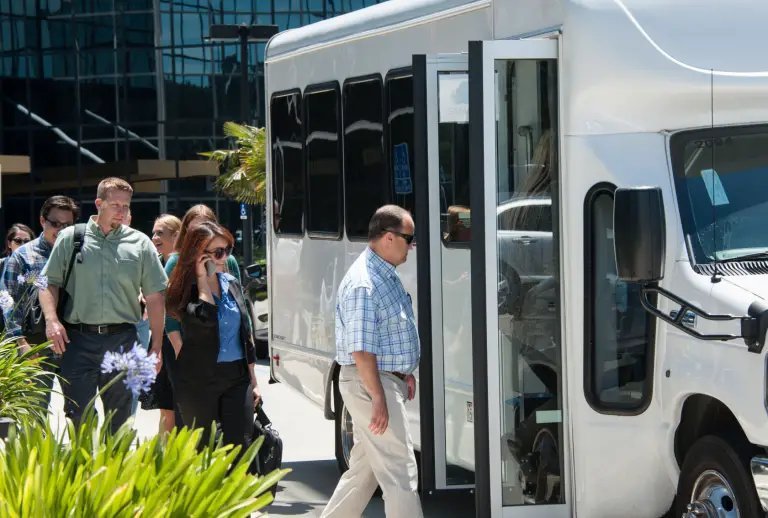20 New Ideas For Choosing Employee Transportation Sites
20 New Ideas For Choosing Employee Transportation Sites
Blog Article
Employee Shuttle Transportation: 10 Tips To Assist You In Planning And Scheduling It.
Here are ten tips on how to plan and be flexible when it comes to employee shuttle service.
1. Assessing employee needs
Assess what your employees need regarding scheduling. You can do this by conducting survey or focus groups about the preferred shuttle times and shift patterns of your employees. Understanding the diverse requirements of your workforce is vital to create schedules that can accommodate as many employees as possible.
2. Set up a flexible Scheduling System
Develop a flexible scheduling system that is able to adjust in response to employee demands. Think about offering different shuttle times to suit the needs of employees working on different shifts. For instance, you could offer shuttles in the early morning to accommodate workers on the first shift or midday alternatives for flexible schedules or late night services for second- and third shift employees.
3. Real-time data can be used to make adjustments
Utilize technology that provides live traffic information and real-time data regarding the number of riders among your employees. This data can help you make informed decisions about when to add new routes or alter shuttle times. Through analyzing the data about patterns of usage it is possible to optimize your scheduling to meet demand effectively.
4. Create a Reservation System
You should think about implementing a reservation system to handle shuttle services. This will allow employees to reserve their seats in advance to ensure there's enough capacity to satisfy demand. A reservation system can also help you identify high-demand times and adjust your scheduling to meet demand, increasing overall efficiency.
5. Communication of Schedule Changes
Make sure that all employees are informed promptly and clearly of any changes to shuttle schedules. To keep employees informed make use of multiple channels for communication such as emails or intranets of the company. A clear communication will help keep employees from being confused and help them prepare for their commute.
6. Monitor Peak Utilization Hours
Monitor shuttle use to identify the peak times for demand. This data will assist you plan your schedule to allow more shuttles during busy times. You can improve the reliability of service and cut down on the wait time for employees by actively managing the peak use.
7. Offer On Demand Services
It is also possible to explore the possibility to provide service on demand for employees who have various schedules. This could include making use of apps that allow employees to request a shuttle whenever they need it. On-demand services enable employees to be flexible and accommodate those with irregular work timetables.
8. Consider Hybrid Models
Implement hybrid scheduling models that combine fixed routes with flexible options. For example, you might have set routes at high traffic times but permit the flexibility of pickups and drop-offs during non-peak times. This will allow you to maximize your efficiency while also accommodating to the employee's schedules.
9. Gather Feedback for Continuous Improvement
Encourage managers and employees to provide feedback on the shuttle schedule and the overall service of transportation. Through regular review of your feedback, you are able to determine areas that need improvement and make adjustments to your schedule. Participating your employees fosters a sense of ownership and can lead to an improved shuttle service.
10. Seasonal changes: Examine them and adapt accordingly
Be aware of any seasonal shifts in employee schedules. For instance, changes to holidays, holiday times during summer, or work hours. Review and update the shuttle schedule to ensure that it can accommodate shifts in availability of employees. Flexibility in scheduling during these times can help maintain the high levels of participation and satisfaction.
Implementing these tips can help companies create a responsive and effective scheduling system for employee shuttle transportation, ensuring that the service can meet the varied needs of the workforce in order to maximize satisfaction and efficiency. Follow the top more hints for employee transportation for site recommendations including private transportation from atlanta airport, los angeles airport transfers, los angeles airport transfers, airporter bus, transport to airport, airport super shuttle, lax airport shuttle bus, shuttle services, pick up service at airport, miami airport transportation and more.
Ten Tips To Help You Create An Economical And Affordable Corporate Event Transportation
Here are 10 tips on cost and budget concerns for a corporate event transportation services:
1. Conduct a thorough Analysis of Costs
Do a thorough cost analysis for all aspects. This includes leasing or rental costs, fuel costs and driver's salaries and insurance, maintenance and any additional fees related to parking permits or permits. Knowing the total costs helps you make a budget that is realistic.
2. Budget Clarity
Set up a budget structure that specifies how much your business is prepared to allocate for transportation. The budget should contain every cost identified, and allow the flexibility to cover unexpected costs. Setting up a budget will help you make better decisions and will help keep your expenses for transportation in check.
3. Explore the various transportation alternatives
Examine the different transportation options that are readily available, including shuttles, vans, and rideshare services. Analyze the cost of each choice by taking into consideration aspects like capacity, comfort, and convenience. The budget for transport can be boosted by choosing the most economical option that best meets participants' needs.
4. How to Negotiate with Transport Providers
When selecting transportation providers ensure that you negotiate contracts in order to get the best rates. Many transportation firms are able and willing to offer discounts on big events and bulk bookings. Building a relationship with your service providers can lead to lower rates and better service. This is ultimately beneficial to your budget.
5. Plan for Fuel Costs
Fuel costs are a major factor in transportation expenses. The distance to the venue and the expected number of trips are crucial. To minimize costs you should try negotiating with the transport company who uses for vehicles that are fuel efficient.
6. Include Contingency Funds
Set aside a part of the budget for contingency funds to cover unexpected costs. Transport isn't always predictable. Vehicle breakdowns and additional trips may occur. The contingency fund ensures such situations can be resolved without compromising the quality or spending too much.
7. Think about Discounts for groups and packages
You can save money by searching for discounts or specials offered by transport providers. Numerous companies offer discounts for large groups, corporate events and other special occasions. This can save you some cash. Ask about packages that offer additional services for a discounted price, such as extra vehicles, or even on-site coordination.
8. Monitor and track expenses
Maintain a close watch on all transportation-related expenses throughout the planning and execution phases. Track costs using spreadsheets or budgeting software. Monitoring expenditures can help identify areas for savings and keeps the budget on track.
9. Gather Feedback for Future Budgeting
After the meeting, collect feedback from participants on their transportation experience. Also, inquire about any additional costs that may be caused by the trip. Reviewing feedback can help you gain insights into the effectiveness of the transportation service and help you plan your budget for the future. Knowing the things that worked and didn't aids in adjusting budgets for the future.
10. Assess the your Total Cost of Ownership
Assess the total cost of ownership (TCO), which includes both the purchase or rental price and ongoing expenses like maintenance insurance, depreciation, and maintenance. It does not only include the cost of the car, but all ongoing expenses, such as maintenance, depreciation, and insurance. Knowing TCO will help you make better decisions and balance upfront costs and the future financial implications.
These tips can aid organizations in managing costs efficiently and make informed choices about budgets for corporate events transport services. A well-planned budget not just ensures that transportation needs are addressed, but also helps to ensure the overall successful event, allowing attendees to focus on the event and not logistical challenges. A well-planned budget and effective cost management will boost the credibility of your business and demonstrate that you are dedicated to accountability and efficiency. Read the most popular event transportation service info for more tips including transportation companies, trailering services, transportation industry, transport mgmt, transportation companies, transport mgmt, group transport, transport logistics company, managed logistics, transportation companies and more.